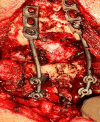Basilar Invagination With Chiari Type I Malformation and Atlanto-Axial Instability: A Rare Case Report
- PMID: 37753030
- PMCID: PMC10518641
- DOI: 10.7759/cureus.44141
Basilar Invagination With Chiari Type I Malformation and Atlanto-Axial Instability: A Rare Case Report
Abstract
Basilar invagination (BI) and Chiari malformation type I (CM-I) are important anomalies involving the craniovertebral junction (CVJ) involving the skull base and occipitocervical region. The incidence of BI is rare involving < 1% of the general population worldwide. They present with varied and complex clinical-radiological features. We present a 36-year-old male who displayed complaints of persistent reeling sensation at our center. Clinical examination revealed bilateral cerebellar signs along with nystagmus and restricted neck movements. Imaging revealed evidence of BI with cerebellar tonsil herniation of ~14.7 mm. Atlantodens interval of 6 mm was noted. The unexpected findings of C1-C2 fusion and instability were also noted. We describe a rare case of BI with C1 prolapse into the foramen magnum along with CM-1 malformation and congenital fusion of C1-C2. We conclude that the treatment algorithm for these rare cases is not very well established and is individually dependent.
Keywords: atlanto-axial fusion; atlantoaxial instability; basilar invagination; chiari malformation; cranio-vertebral junction.
Copyright © 2023, Sanjay et al.
Conflict of interest statement
The authors have declared that no competing interests exist.
Figures








References
-
- Hindbrain herniation syndromes: the Chiari malformations (I and II) Cai C, Oakes WJ. Semin Pediatr Neurol. 1997;4:179–191. - PubMed
-
- Donnally III CJ, Munakomi S, Varacallo M. StatPearls. Treasure Island (FL. Vol. 6. Treasure Island, FL: StatPearls Publishing; 2023. Basilar Invagination. - PubMed
-
- Craniovertebral junction: normal anatomy, craniometry, and congenital anomalies. Smoker WR. Radiographics. 1994;14:255–277. - PubMed
Publication types
LinkOut - more resources
Full Text Sources
Miscellaneous
